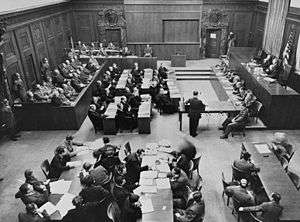Ministries Trial

The Ministries Trial (or, officially, the United States of America vs. Ernst von Weizsäcker, et al.) was the eleventh of the twelve trials for war crimes the U.S. authorities held in their occupation zone in Germany in Nuremberg after the end of World War II. These twelve trials were all held before U.S. military courts, not before the International Military Tribunal, but took place in the same rooms at the Palace of Justice. The twelve U.S. trials are collectively known as the "Subsequent Nuremberg Trials" or, more formally, as the "Trials of War Criminals before the Nuremberg Military Tribunals" (NMT).
This case is also known as the Wilhelmstrasse Trial, so-named because the German Foreign Office was located at the Wilhelmstrasse in Berlin. The defendants in this case were officials of various Reich ministries, facing various charges for their roles in Nazi Germany and thus their participation in or responsibility for the numerous atrocities committed both in Germany and in occupied countries during the war.
The judges in this case, heard before Military Tribunal VI, were William C. Christianson (presiding judge) from Minnesota, Robert F. Maguire from Oregon and Leon W. Powers from Iowa. The Chief of Counsel for the Prosecution was Telford Taylor; the chief prosecutor was Robert Kempner. The indictment was filed on 15 November 1947; the hearings lasted from 6 January 1948 until 18 November that year, and then the judges took a whole five months to compile their 833-page judgment, which they presented on 11 April 1949. The sentences were handed down on 13 April 1949. Of all the twelve trials, this was the one that lasted longest and ended last. Of the 21 defendants arraigned, two were acquitted, the others were found guilty on at least one count of the indictment and received prison sentences ranging from three years including time served to 25 years' imprisonment.
Defendants
| Name | Photo | Function | Sentence |
|---|---|---|---|
| Ernst von Weizsäcker | Permanent Secretary of State in the Auswärtiges Amt (Foreign Ministry) under Ribbentrop until 1943, then ambassador to the Holy See; SS-Brigadeführer. | 7 years' imprisonment; reduced to 5 years on 12 December 1949, released in October 1950. | |
| Gustav Adolf Steengracht von Moyland | Successor of von Weizsäcker as Secretary of State in the Foreign Ministry (until 1945) | 7 years' imprisonment; reduced to 5 years on 12 December 1949, released 1950 | |
| Wilhelm Keppler | Secretary of State; Hitler's advisor for economy | 10 years' imprisonment; released 1951 | |
| Ernst Wilhelm Bohle | NS-Gauleiter, Secretary of State in the Foreign Ministry; head of the Auslandorganisation (foreign organization) of the NSDAP. | 5 years' imprisonment | |
| Ernst Wörmann | Secretary in the Foreign Ministry; head of the political division. German Ambassador to China, Wang Jingwei regime. | 7 years' imprisonment; reduced to 5 years on 12 December 1949; released 1951 | |
| Karl Ritter | Liaison between Foreign Office and the High Command of the German armed forces. | 4 years' imprisonment incl. time already served; released after the judgment. | |
| Otto von Erdmannsdorff | Secretary in the Foreign Ministry; deputy to Wörmann. | acquitted | |
| Edmund Veesenmayer | Plenipotentiary in Hungary | 20 years' imprisonment; reduced to 10 years in 1951 and released the same year. | |
| Hans Heinrich Lammers | Head of the Reich Chancellery | 20 years' imprisonment; reduced to 10 years in January 1951 and released 16 December 1951. | |
| Wilhelm Stuckart | |
Secretary of State in the Interior Ministry | Time already served (3 years and 10 months)1 |
| Richard Walther Darré | Minister for Food and Agriculture | 7 years' imprisonment; released 1950 | |
| Otto Meissner | Head of the Presidential Chancellery | acquitted | |
| Otto Dietrich | Reichspressechef of the NSDAP and Secretary of State in the Propagandaministerium | 7 years' imprisonment incl. time already served; released in 1950. | |
| Gottlob Berger | Head of the SS-Hauptamt, SS-Obergruppenführer | 25 years' imprisonment; reduced to 10 years in 1951; released the same year. | |
| Walter Schellenberg | Second-in-command of the Gestapo, head of the SD and the Abwehr, and successor of Wilhelm Canaris as the head of the Combined Secret Services; SS-Brigadeführer. | 6 years' imprisonment incl. time already served | |
| Lutz Graf Schwerin von Krosigk | Minister of Finance | 10 years' imprisonment; released in 1951 | |
| Emil Puhl | Vice-president of the Reichsbank | 5 years' imprisonment incl. time already served | |
| Karl Rasche | Director of the Dresdner Bank | 7 years' imprisonment including time already served | |
| Paul Körner | Secretary of State, deputy of Göring. | 15 years' imprisonment; reduced to 10 years in 1951; released the same year. | |
| Paul Pleiger | Head of the Reichswerke Hermann Göring (confiscated steel plants employing slave laborers) | 15 years' imprisonment; reduced to 10 years in 1951; released the same year. | |
| Hans Kehrl | Secretary in the Ministry of Armament; head of the planning office | 15 years' imprisonment; released in 1951 |
^1 Stuckart was tried again in 1950 before a denazification court and sentenced as a Mitläufer (follower) a fine of DM 50,000.
Herbert Backe, the former minister for agriculture who should also have been tried, committed suicide on 6 April 1947 while in custody awaiting the trial.
References
| Wikimedia Commons has media related to Ministries trial. |
- Description from the U.S. Holocaust Memorial Museum.
- Another description
- Transcript of a German radio broadcast from 1999 (in German).
